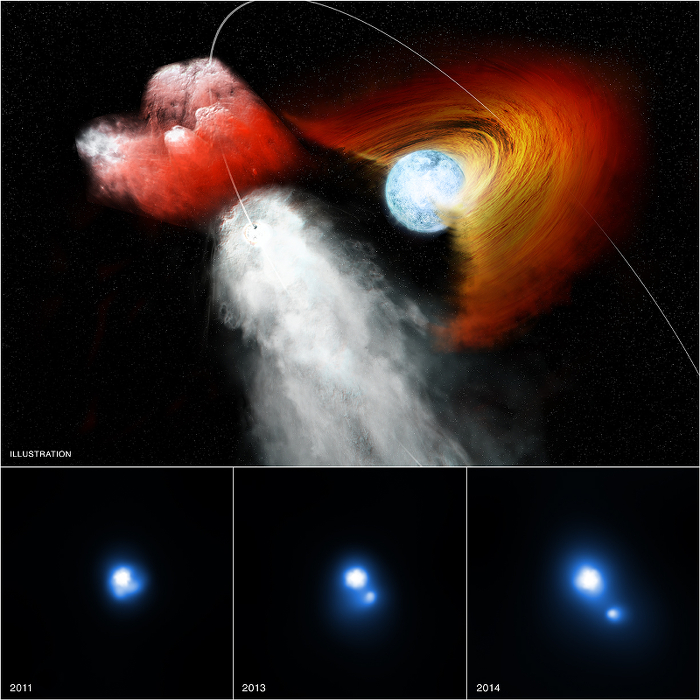
 Credit: X-ray: NASA/CXC/PSU/G.Pavlov et al; Illustration: NASA/CXC/M.Weiss
Credit: X-ray: NASA/CXC/PSU/G.Pavlov et al; Illustration: NASA/CXC/M.Weiss
Ejected
PSR B1259-63 is an unusual binary star system in which a star about 30 times more massive than the Sun is orbited by a pulsar, an ultra-dense rapidly spinning, highly magnetized neutron star. At one time (possibly a few hundred thousand years ago), this system probably consisted of the 30 solar mass star and an even more massive companion star. This more massive star, the progenitor of the neutron star, would have run through its core thermonuclear evolution and exploded as a core-collapse supernova, expelling most of its mass and leaving behind the pulsar. The 30 solar mass star itself spins rapidly, and this rapid spin has apparently produced a disk of stellar material around its stellar equator. The elliptical orbit of the pulsar around the 30 solar mass star is highly eccentric, so that for a short time the pulsar is close enough to the normal star to pass through the equatorial disk. When this happens, strong changes in the radio and X-ray emission from the pulsar have been observed. But something else seems to have happened as well. High spatial resolution X-ray observations from the Chandra X-ray Telescope over a 3-year period (and shown in the lower part of the image above) show the presence of an X-ray emitting object which seems to be moving away from PSR B1259-63. Astronomers believe that this object is a large clump of gas which was violently ejected from the disk around the massive star by the pulsar as it passed through the stellar disk. The upper part of the image above illustrates the ejection of the clump, showing the pulsar in its 3.4-year orbit just after it collided with the disk. The Chandra observations show that the clump is moving at about 7 percent of the speed of light, and it may be accelerating. The X-ray emission from the clump is probably produced by a high-energy shock wave produced as the pulsar's wind rams into the clump of material.
Published: September 7, 2015
<
HEA Dictionary ● Archive
● Search HEAPOW
● Other Languages
● HEAPOW on Facebook
● Download all Images
● Education ● HEAD
>

Each week the HEASARC
brings you new, exciting and beautiful images from X-ray and Gamma ray
astronomy. Check back each week and be sure to check out the HEAPOW archive!
Page Author: Dr. Michael F. Corcoran
Last modified Monday, 26-Feb-2024 17:23:09 EST


